Impact of Government Intervention on TB in London's BME Groups
VerifiedAdded on 2023/01/16
|14
|4418
|71
Report
AI Summary
This research proposal investigates the impact of government intervention, specifically the NHS Health Check program, on tackling Tuberculosis (TB) among Black and Minority Ethnic (BME) communities in London. The introduction highlights TB as a serious infectious disease, with London identified as a European TB capital due to high incidence rates. The background and rationale section explores TB's causes, symptoms, and risk factors, emphasizing its disproportionate impact on BME communities and the role of socioeconomic factors. The study aims to ascertain the impact of the NHS Health Check in addressing TB within these communities. The objectives include determining TB prevalence, identifying risk factors, investigating health implications, and assessing the intervention's impact. The methodology relies on secondary research, utilizing existing data from various sources to analyze the issue. The proposal also outlines ethical considerations, a project outline, and a timetable to guide the research process. The proposal underscores the need for effective interventions to reduce TB prevalence and improve health outcomes among BME communities in London.
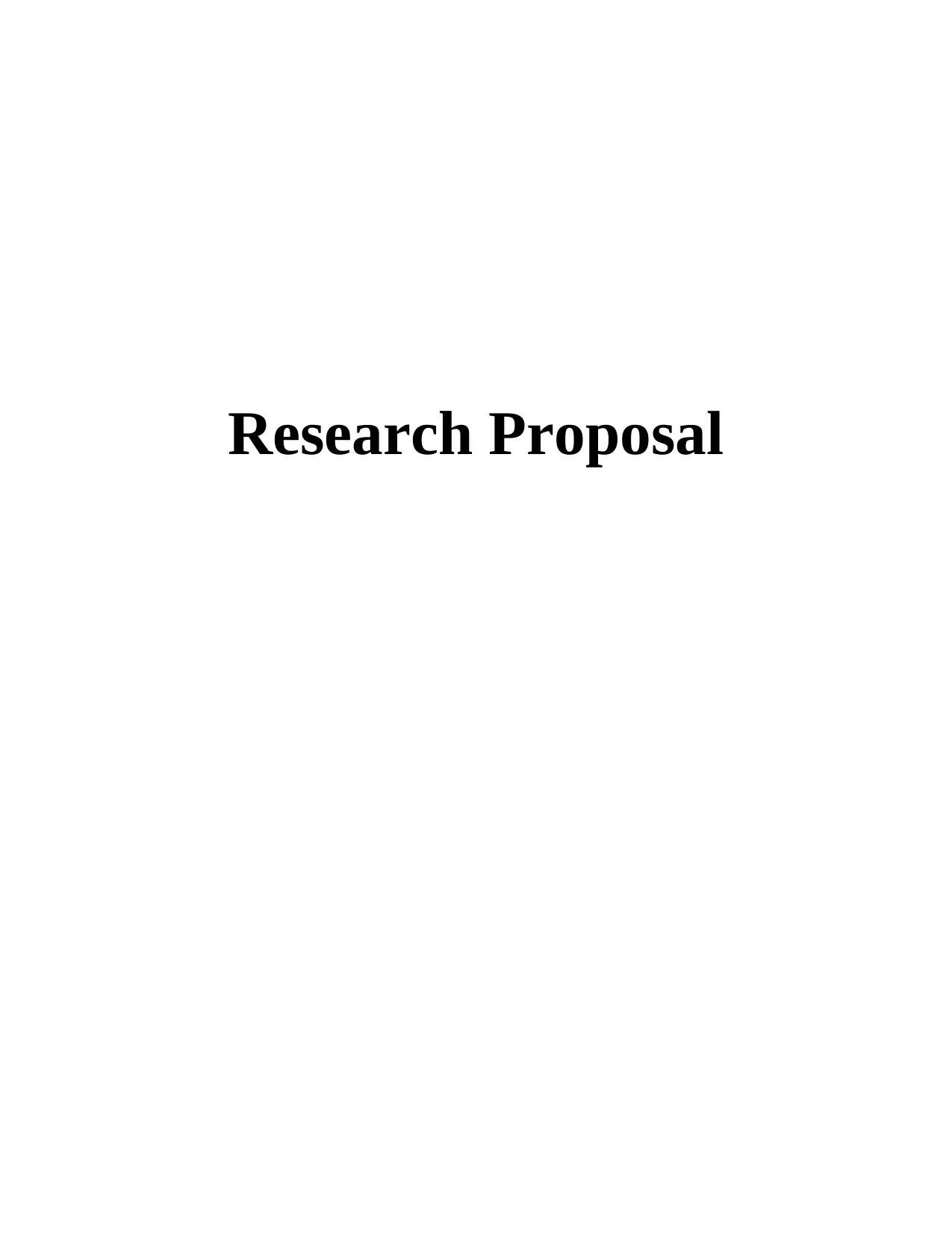
Research Proposal
Secure Best Marks with AI Grader
Need help grading? Try our AI Grader for instant feedback on your assignments.
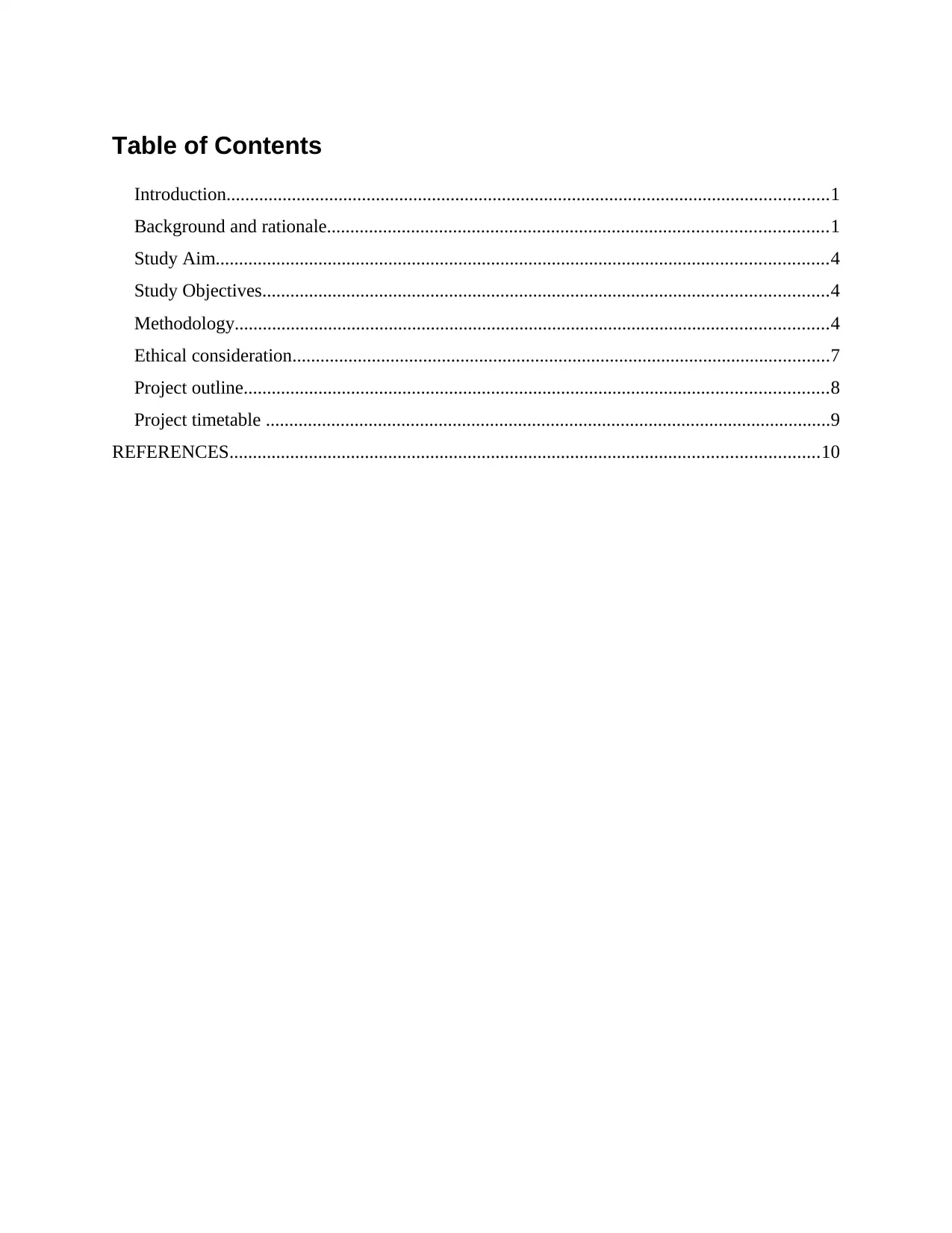
Table of Contents
Introduction.................................................................................................................................1
Background and rationale...........................................................................................................1
Study Aim...................................................................................................................................4
Study Objectives.........................................................................................................................4
Methodology...............................................................................................................................4
Ethical consideration...................................................................................................................7
Project outline.............................................................................................................................8
Project timetable .........................................................................................................................9
REFERENCES..............................................................................................................................10
Introduction.................................................................................................................................1
Background and rationale...........................................................................................................1
Study Aim...................................................................................................................................4
Study Objectives.........................................................................................................................4
Methodology...............................................................................................................................4
Ethical consideration...................................................................................................................7
Project outline.............................................................................................................................8
Project timetable .........................................................................................................................9
REFERENCES..............................................................................................................................10
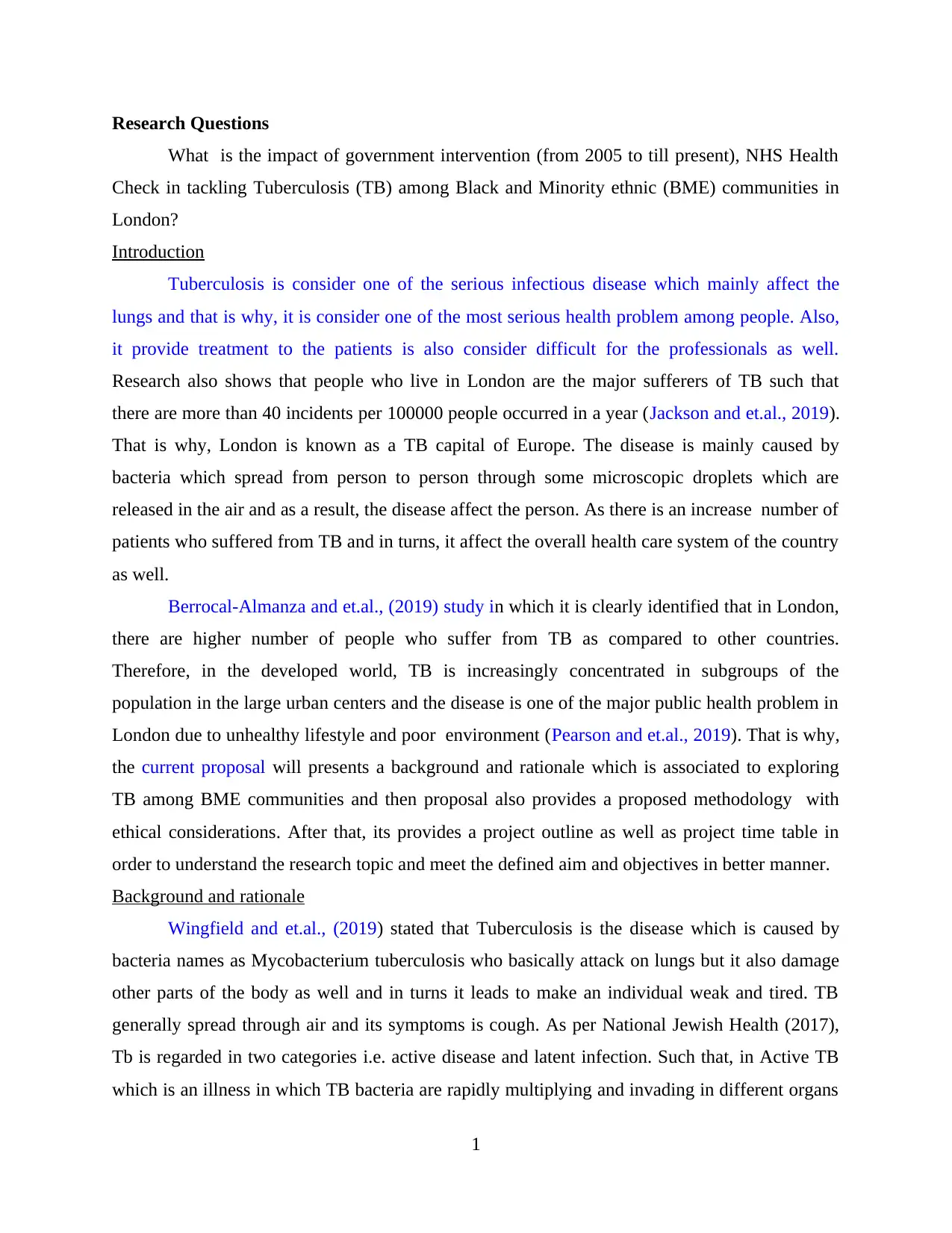
Research Questions
What is the impact of government intervention (from 2005 to till present), NHS Health
Check in tackling Tuberculosis (TB) among Black and Minority ethnic (BME) communities in
London?
Introduction
Tuberculosis is consider one of the serious infectious disease which mainly affect the
lungs and that is why, it is consider one of the most serious health problem among people. Also,
it provide treatment to the patients is also consider difficult for the professionals as well.
Research also shows that people who live in London are the major sufferers of TB such that
there are more than 40 incidents per 100000 people occurred in a year (Jackson and et.al., 2019).
That is why, London is known as a TB capital of Europe. The disease is mainly caused by
bacteria which spread from person to person through some microscopic droplets which are
released in the air and as a result, the disease affect the person. As there is an increase number of
patients who suffered from TB and in turns, it affect the overall health care system of the country
as well.
Berrocal-Almanza and et.al., (2019) study in which it is clearly identified that in London,
there are higher number of people who suffer from TB as compared to other countries.
Therefore, in the developed world, TB is increasingly concentrated in subgroups of the
population in the large urban centers and the disease is one of the major public health problem in
London due to unhealthy lifestyle and poor environment (Pearson and et.al., 2019). That is why,
the current proposal will presents a background and rationale which is associated to exploring
TB among BME communities and then proposal also provides a proposed methodology with
ethical considerations. After that, its provides a project outline as well as project time table in
order to understand the research topic and meet the defined aim and objectives in better manner.
Background and rationale
Wingfield and et.al., (2019) stated that Tuberculosis is the disease which is caused by
bacteria names as Mycobacterium tuberculosis who basically attack on lungs but it also damage
other parts of the body as well and in turns it leads to make an individual weak and tired. TB
generally spread through air and its symptoms is cough. As per National Jewish Health (2017),
Tb is regarded in two categories i.e. active disease and latent infection. Such that, in Active TB
which is an illness in which TB bacteria are rapidly multiplying and invading in different organs
1
What is the impact of government intervention (from 2005 to till present), NHS Health
Check in tackling Tuberculosis (TB) among Black and Minority ethnic (BME) communities in
London?
Introduction
Tuberculosis is consider one of the serious infectious disease which mainly affect the
lungs and that is why, it is consider one of the most serious health problem among people. Also,
it provide treatment to the patients is also consider difficult for the professionals as well.
Research also shows that people who live in London are the major sufferers of TB such that
there are more than 40 incidents per 100000 people occurred in a year (Jackson and et.al., 2019).
That is why, London is known as a TB capital of Europe. The disease is mainly caused by
bacteria which spread from person to person through some microscopic droplets which are
released in the air and as a result, the disease affect the person. As there is an increase number of
patients who suffered from TB and in turns, it affect the overall health care system of the country
as well.
Berrocal-Almanza and et.al., (2019) study in which it is clearly identified that in London,
there are higher number of people who suffer from TB as compared to other countries.
Therefore, in the developed world, TB is increasingly concentrated in subgroups of the
population in the large urban centers and the disease is one of the major public health problem in
London due to unhealthy lifestyle and poor environment (Pearson and et.al., 2019). That is why,
the current proposal will presents a background and rationale which is associated to exploring
TB among BME communities and then proposal also provides a proposed methodology with
ethical considerations. After that, its provides a project outline as well as project time table in
order to understand the research topic and meet the defined aim and objectives in better manner.
Background and rationale
Wingfield and et.al., (2019) stated that Tuberculosis is the disease which is caused by
bacteria names as Mycobacterium tuberculosis who basically attack on lungs but it also damage
other parts of the body as well and in turns it leads to make an individual weak and tired. TB
generally spread through air and its symptoms is cough. As per National Jewish Health (2017),
Tb is regarded in two categories i.e. active disease and latent infection. Such that, in Active TB
which is an illness in which TB bacteria are rapidly multiplying and invading in different organs
1
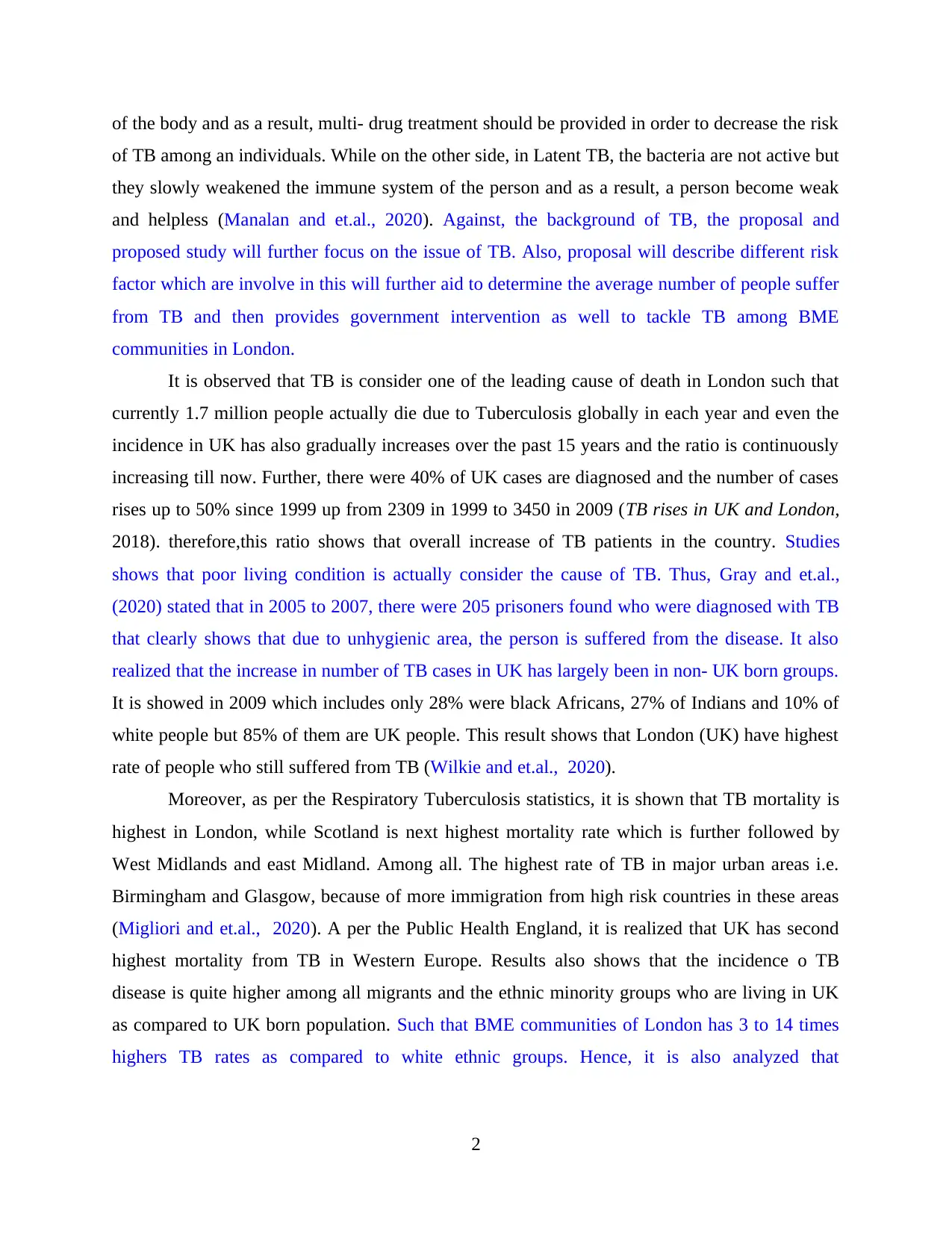
of the body and as a result, multi- drug treatment should be provided in order to decrease the risk
of TB among an individuals. While on the other side, in Latent TB, the bacteria are not active but
they slowly weakened the immune system of the person and as a result, a person become weak
and helpless (Manalan and et.al., 2020). Against, the background of TB, the proposal and
proposed study will further focus on the issue of TB. Also, proposal will describe different risk
factor which are involve in this will further aid to determine the average number of people suffer
from TB and then provides government intervention as well to tackle TB among BME
communities in London.
It is observed that TB is consider one of the leading cause of death in London such that
currently 1.7 million people actually die due to Tuberculosis globally in each year and even the
incidence in UK has also gradually increases over the past 15 years and the ratio is continuously
increasing till now. Further, there were 40% of UK cases are diagnosed and the number of cases
rises up to 50% since 1999 up from 2309 in 1999 to 3450 in 2009 (TB rises in UK and London,
2018). therefore,this ratio shows that overall increase of TB patients in the country. Studies
shows that poor living condition is actually consider the cause of TB. Thus, Gray and et.al.,
(2020) stated that in 2005 to 2007, there were 205 prisoners found who were diagnosed with TB
that clearly shows that due to unhygienic area, the person is suffered from the disease. It also
realized that the increase in number of TB cases in UK has largely been in non- UK born groups.
It is showed in 2009 which includes only 28% were black Africans, 27% of Indians and 10% of
white people but 85% of them are UK people. This result shows that London (UK) have highest
rate of people who still suffered from TB (Wilkie and et.al., 2020).
Moreover, as per the Respiratory Tuberculosis statistics, it is shown that TB mortality is
highest in London, while Scotland is next highest mortality rate which is further followed by
West Midlands and east Midland. Among all. The highest rate of TB in major urban areas i.e.
Birmingham and Glasgow, because of more immigration from high risk countries in these areas
(Migliori and et.al., 2020). A per the Public Health England, it is realized that UK has second
highest mortality from TB in Western Europe. Results also shows that the incidence o TB
disease is quite higher among all migrants and the ethnic minority groups who are living in UK
as compared to UK born population. Such that BME communities of London has 3 to 14 times
highers TB rates as compared to white ethnic groups. Hence, it is also analyzed that
2
of TB among an individuals. While on the other side, in Latent TB, the bacteria are not active but
they slowly weakened the immune system of the person and as a result, a person become weak
and helpless (Manalan and et.al., 2020). Against, the background of TB, the proposal and
proposed study will further focus on the issue of TB. Also, proposal will describe different risk
factor which are involve in this will further aid to determine the average number of people suffer
from TB and then provides government intervention as well to tackle TB among BME
communities in London.
It is observed that TB is consider one of the leading cause of death in London such that
currently 1.7 million people actually die due to Tuberculosis globally in each year and even the
incidence in UK has also gradually increases over the past 15 years and the ratio is continuously
increasing till now. Further, there were 40% of UK cases are diagnosed and the number of cases
rises up to 50% since 1999 up from 2309 in 1999 to 3450 in 2009 (TB rises in UK and London,
2018). therefore,this ratio shows that overall increase of TB patients in the country. Studies
shows that poor living condition is actually consider the cause of TB. Thus, Gray and et.al.,
(2020) stated that in 2005 to 2007, there were 205 prisoners found who were diagnosed with TB
that clearly shows that due to unhygienic area, the person is suffered from the disease. It also
realized that the increase in number of TB cases in UK has largely been in non- UK born groups.
It is showed in 2009 which includes only 28% were black Africans, 27% of Indians and 10% of
white people but 85% of them are UK people. This result shows that London (UK) have highest
rate of people who still suffered from TB (Wilkie and et.al., 2020).
Moreover, as per the Respiratory Tuberculosis statistics, it is shown that TB mortality is
highest in London, while Scotland is next highest mortality rate which is further followed by
West Midlands and east Midland. Among all. The highest rate of TB in major urban areas i.e.
Birmingham and Glasgow, because of more immigration from high risk countries in these areas
(Migliori and et.al., 2020). A per the Public Health England, it is realized that UK has second
highest mortality from TB in Western Europe. Results also shows that the incidence o TB
disease is quite higher among all migrants and the ethnic minority groups who are living in UK
as compared to UK born population. Such that BME communities of London has 3 to 14 times
highers TB rates as compared to white ethnic groups. Hence, it is also analyzed that
2
Secure Best Marks with AI Grader
Need help grading? Try our AI Grader for instant feedback on your assignments.
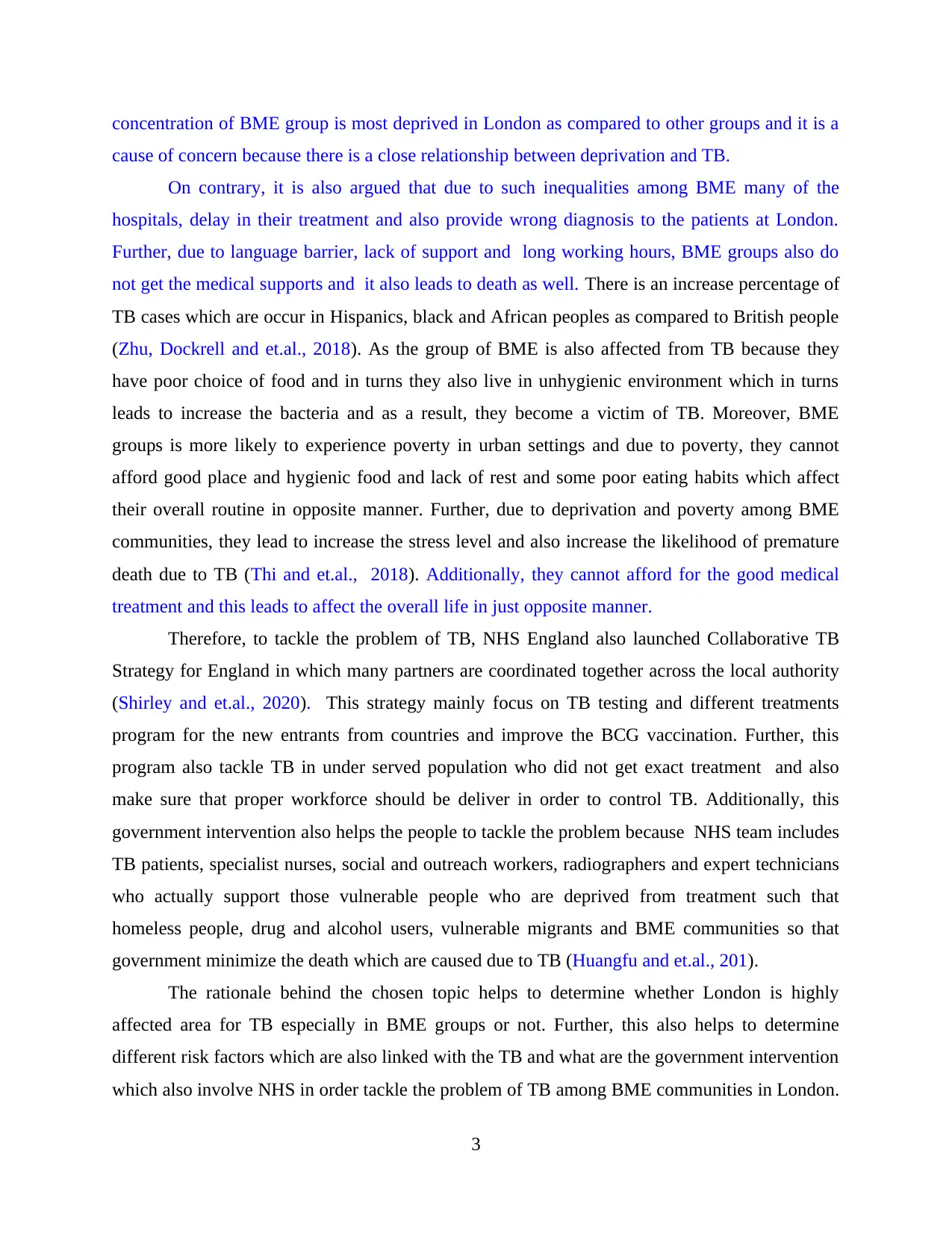
concentration of BME group is most deprived in London as compared to other groups and it is a
cause of concern because there is a close relationship between deprivation and TB.
On contrary, it is also argued that due to such inequalities among BME many of the
hospitals, delay in their treatment and also provide wrong diagnosis to the patients at London.
Further, due to language barrier, lack of support and long working hours, BME groups also do
not get the medical supports and it also leads to death as well. There is an increase percentage of
TB cases which are occur in Hispanics, black and African peoples as compared to British people
(Zhu, Dockrell and et.al., 2018). As the group of BME is also affected from TB because they
have poor choice of food and in turns they also live in unhygienic environment which in turns
leads to increase the bacteria and as a result, they become a victim of TB. Moreover, BME
groups is more likely to experience poverty in urban settings and due to poverty, they cannot
afford good place and hygienic food and lack of rest and some poor eating habits which affect
their overall routine in opposite manner. Further, due to deprivation and poverty among BME
communities, they lead to increase the stress level and also increase the likelihood of premature
death due to TB (Thi and et.al., 2018). Additionally, they cannot afford for the good medical
treatment and this leads to affect the overall life in just opposite manner.
Therefore, to tackle the problem of TB, NHS England also launched Collaborative TB
Strategy for England in which many partners are coordinated together across the local authority
(Shirley and et.al., 2020). This strategy mainly focus on TB testing and different treatments
program for the new entrants from countries and improve the BCG vaccination. Further, this
program also tackle TB in under served population who did not get exact treatment and also
make sure that proper workforce should be deliver in order to control TB. Additionally, this
government intervention also helps the people to tackle the problem because NHS team includes
TB patients, specialist nurses, social and outreach workers, radiographers and expert technicians
who actually support those vulnerable people who are deprived from treatment such that
homeless people, drug and alcohol users, vulnerable migrants and BME communities so that
government minimize the death which are caused due to TB (Huangfu and et.al., 201).
The rationale behind the chosen topic helps to determine whether London is highly
affected area for TB especially in BME groups or not. Further, this also helps to determine
different risk factors which are also linked with the TB and what are the government intervention
which also involve NHS in order tackle the problem of TB among BME communities in London.
3
cause of concern because there is a close relationship between deprivation and TB.
On contrary, it is also argued that due to such inequalities among BME many of the
hospitals, delay in their treatment and also provide wrong diagnosis to the patients at London.
Further, due to language barrier, lack of support and long working hours, BME groups also do
not get the medical supports and it also leads to death as well. There is an increase percentage of
TB cases which are occur in Hispanics, black and African peoples as compared to British people
(Zhu, Dockrell and et.al., 2018). As the group of BME is also affected from TB because they
have poor choice of food and in turns they also live in unhygienic environment which in turns
leads to increase the bacteria and as a result, they become a victim of TB. Moreover, BME
groups is more likely to experience poverty in urban settings and due to poverty, they cannot
afford good place and hygienic food and lack of rest and some poor eating habits which affect
their overall routine in opposite manner. Further, due to deprivation and poverty among BME
communities, they lead to increase the stress level and also increase the likelihood of premature
death due to TB (Thi and et.al., 2018). Additionally, they cannot afford for the good medical
treatment and this leads to affect the overall life in just opposite manner.
Therefore, to tackle the problem of TB, NHS England also launched Collaborative TB
Strategy for England in which many partners are coordinated together across the local authority
(Shirley and et.al., 2020). This strategy mainly focus on TB testing and different treatments
program for the new entrants from countries and improve the BCG vaccination. Further, this
program also tackle TB in under served population who did not get exact treatment and also
make sure that proper workforce should be deliver in order to control TB. Additionally, this
government intervention also helps the people to tackle the problem because NHS team includes
TB patients, specialist nurses, social and outreach workers, radiographers and expert technicians
who actually support those vulnerable people who are deprived from treatment such that
homeless people, drug and alcohol users, vulnerable migrants and BME communities so that
government minimize the death which are caused due to TB (Huangfu and et.al., 201).
The rationale behind the chosen topic helps to determine whether London is highly
affected area for TB especially in BME groups or not. Further, this also helps to determine
different risk factors which are also linked with the TB and what are the government intervention
which also involve NHS in order tackle the problem of TB among BME communities in London.
3
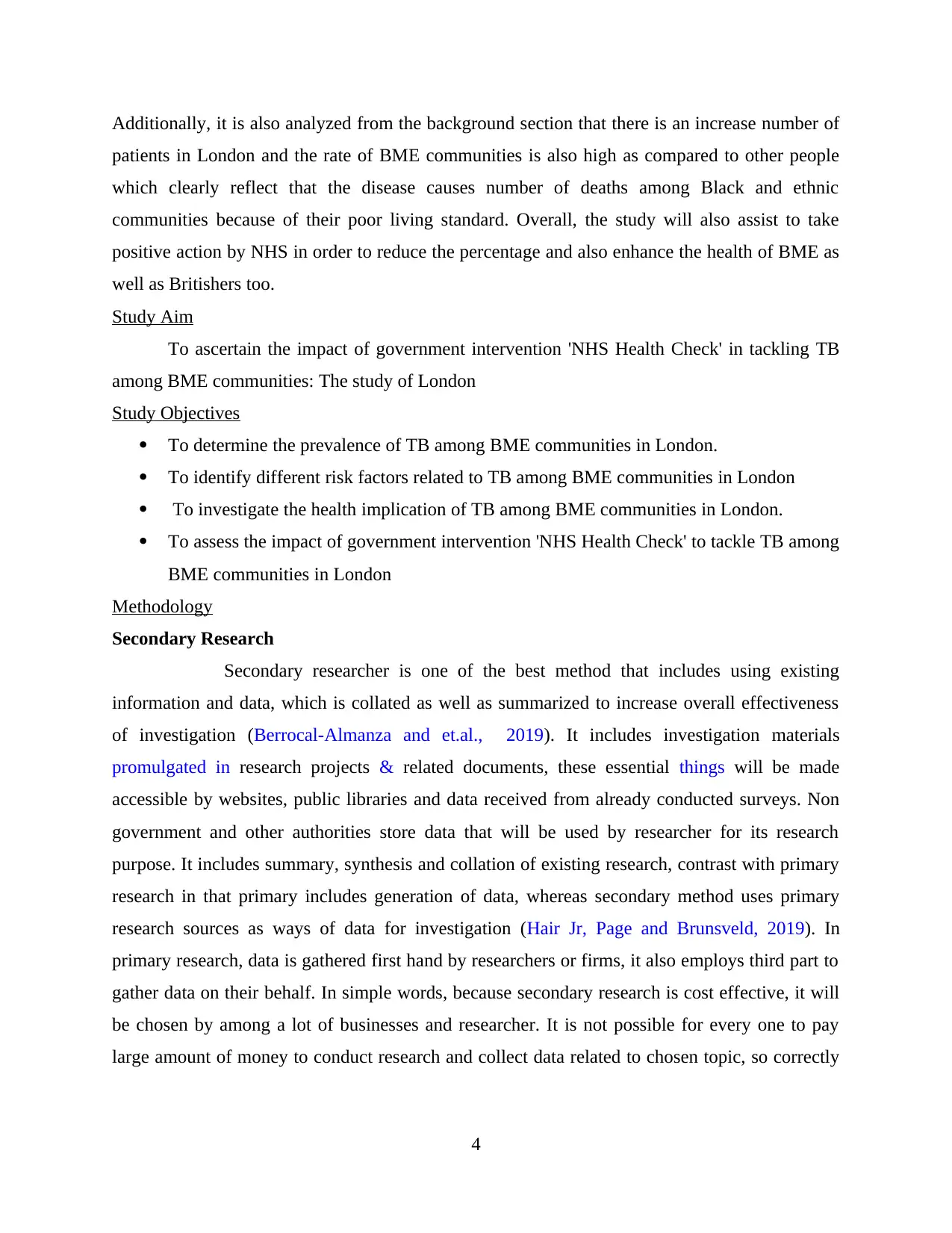
Additionally, it is also analyzed from the background section that there is an increase number of
patients in London and the rate of BME communities is also high as compared to other people
which clearly reflect that the disease causes number of deaths among Black and ethnic
communities because of their poor living standard. Overall, the study will also assist to take
positive action by NHS in order to reduce the percentage and also enhance the health of BME as
well as Britishers too.
Study Aim
To ascertain the impact of government intervention 'NHS Health Check' in tackling TB
among BME communities: The study of London
Study Objectives
To determine the prevalence of TB among BME communities in London.
To identify different risk factors related to TB among BME communities in London
To investigate the health implication of TB among BME communities in London.
To assess the impact of government intervention 'NHS Health Check' to tackle TB among
BME communities in London
Methodology
Secondary Research
Secondary researcher is one of the best method that includes using existing
information and data, which is collated as well as summarized to increase overall effectiveness
of investigation (Berrocal-Almanza and et.al., 2019). It includes investigation materials
promulgated in research projects & related documents, these essential things will be made
accessible by websites, public libraries and data received from already conducted surveys. Non
government and other authorities store data that will be used by researcher for its research
purpose. It includes summary, synthesis and collation of existing research, contrast with primary
research in that primary includes generation of data, whereas secondary method uses primary
research sources as ways of data for investigation (Hair Jr, Page and Brunsveld, 2019). In
primary research, data is gathered first hand by researchers or firms, it also employs third part to
gather data on their behalf. In simple words, because secondary research is cost effective, it will
be chosen by among a lot of businesses and researcher. It is not possible for every one to pay
large amount of money to conduct research and collect data related to chosen topic, so correctly
4
patients in London and the rate of BME communities is also high as compared to other people
which clearly reflect that the disease causes number of deaths among Black and ethnic
communities because of their poor living standard. Overall, the study will also assist to take
positive action by NHS in order to reduce the percentage and also enhance the health of BME as
well as Britishers too.
Study Aim
To ascertain the impact of government intervention 'NHS Health Check' in tackling TB
among BME communities: The study of London
Study Objectives
To determine the prevalence of TB among BME communities in London.
To identify different risk factors related to TB among BME communities in London
To investigate the health implication of TB among BME communities in London.
To assess the impact of government intervention 'NHS Health Check' to tackle TB among
BME communities in London
Methodology
Secondary Research
Secondary researcher is one of the best method that includes using existing
information and data, which is collated as well as summarized to increase overall effectiveness
of investigation (Berrocal-Almanza and et.al., 2019). It includes investigation materials
promulgated in research projects & related documents, these essential things will be made
accessible by websites, public libraries and data received from already conducted surveys. Non
government and other authorities store data that will be used by researcher for its research
purpose. It includes summary, synthesis and collation of existing research, contrast with primary
research in that primary includes generation of data, whereas secondary method uses primary
research sources as ways of data for investigation (Hair Jr, Page and Brunsveld, 2019). In
primary research, data is gathered first hand by researchers or firms, it also employs third part to
gather data on their behalf. In simple words, because secondary research is cost effective, it will
be chosen by among a lot of businesses and researcher. It is not possible for every one to pay
large amount of money to conduct research and collect data related to chosen topic, so correctly
4
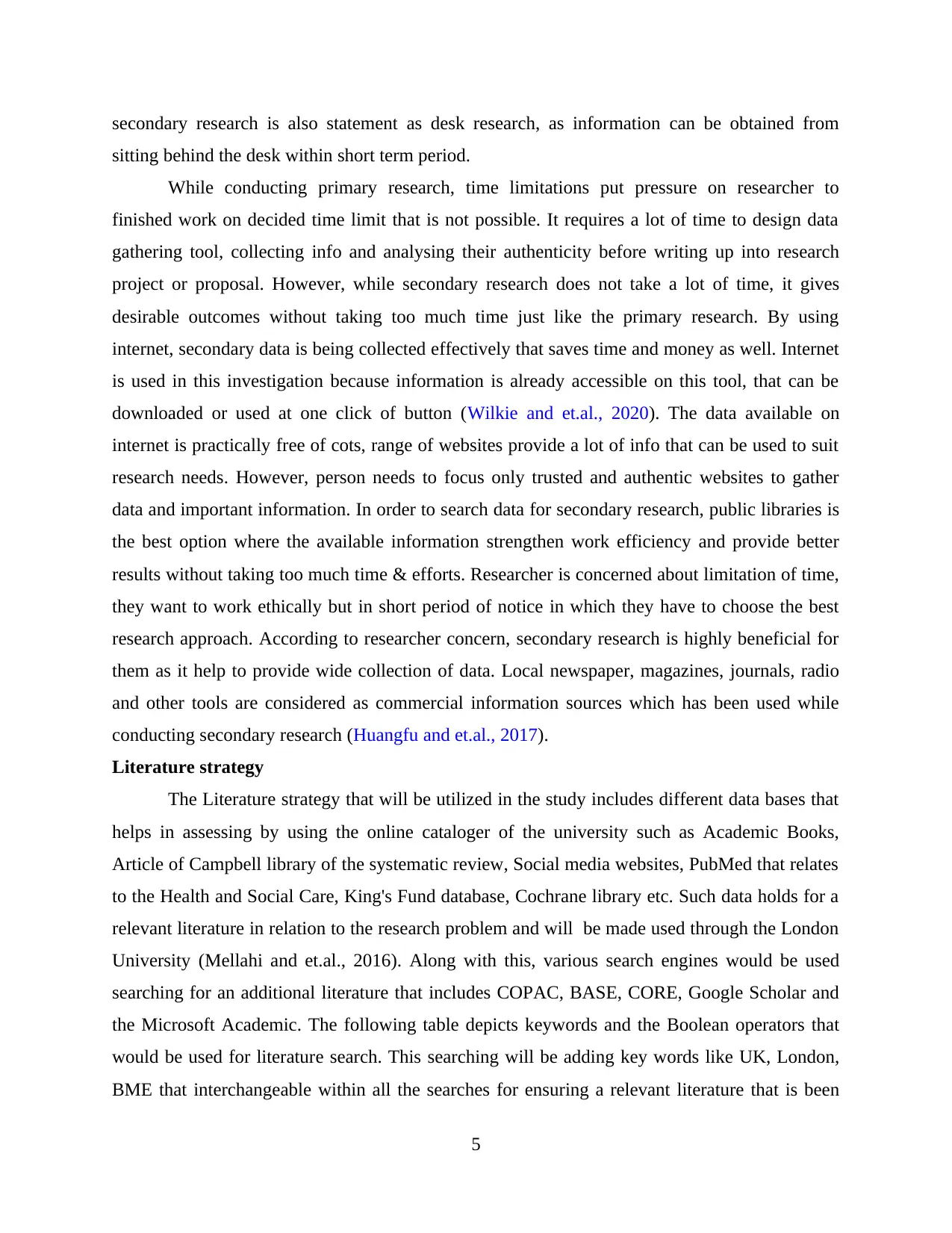
secondary research is also statement as desk research, as information can be obtained from
sitting behind the desk within short term period.
While conducting primary research, time limitations put pressure on researcher to
finished work on decided time limit that is not possible. It requires a lot of time to design data
gathering tool, collecting info and analysing their authenticity before writing up into research
project or proposal. However, while secondary research does not take a lot of time, it gives
desirable outcomes without taking too much time just like the primary research. By using
internet, secondary data is being collected effectively that saves time and money as well. Internet
is used in this investigation because information is already accessible on this tool, that can be
downloaded or used at one click of button (Wilkie and et.al., 2020). The data available on
internet is practically free of cots, range of websites provide a lot of info that can be used to suit
research needs. However, person needs to focus only trusted and authentic websites to gather
data and important information. In order to search data for secondary research, public libraries is
the best option where the available information strengthen work efficiency and provide better
results without taking too much time & efforts. Researcher is concerned about limitation of time,
they want to work ethically but in short period of notice in which they have to choose the best
research approach. According to researcher concern, secondary research is highly beneficial for
them as it help to provide wide collection of data. Local newspaper, magazines, journals, radio
and other tools are considered as commercial information sources which has been used while
conducting secondary research (Huangfu and et.al., 2017).
Literature strategy
The Literature strategy that will be utilized in the study includes different data bases that
helps in assessing by using the online cataloger of the university such as Academic Books,
Article of Campbell library of the systematic review, Social media websites, PubMed that relates
to the Health and Social Care, King's Fund database, Cochrane library etc. Such data holds for a
relevant literature in relation to the research problem and will be made used through the London
University (Mellahi and et.al., 2016). Along with this, various search engines would be used
searching for an additional literature that includes COPAC, BASE, CORE, Google Scholar and
the Microsoft Academic. The following table depicts keywords and the Boolean operators that
would be used for literature search. This searching will be adding key words like UK, London,
BME that interchangeable within all the searches for ensuring a relevant literature that is been
5
sitting behind the desk within short term period.
While conducting primary research, time limitations put pressure on researcher to
finished work on decided time limit that is not possible. It requires a lot of time to design data
gathering tool, collecting info and analysing their authenticity before writing up into research
project or proposal. However, while secondary research does not take a lot of time, it gives
desirable outcomes without taking too much time just like the primary research. By using
internet, secondary data is being collected effectively that saves time and money as well. Internet
is used in this investigation because information is already accessible on this tool, that can be
downloaded or used at one click of button (Wilkie and et.al., 2020). The data available on
internet is practically free of cots, range of websites provide a lot of info that can be used to suit
research needs. However, person needs to focus only trusted and authentic websites to gather
data and important information. In order to search data for secondary research, public libraries is
the best option where the available information strengthen work efficiency and provide better
results without taking too much time & efforts. Researcher is concerned about limitation of time,
they want to work ethically but in short period of notice in which they have to choose the best
research approach. According to researcher concern, secondary research is highly beneficial for
them as it help to provide wide collection of data. Local newspaper, magazines, journals, radio
and other tools are considered as commercial information sources which has been used while
conducting secondary research (Huangfu and et.al., 2017).
Literature strategy
The Literature strategy that will be utilized in the study includes different data bases that
helps in assessing by using the online cataloger of the university such as Academic Books,
Article of Campbell library of the systematic review, Social media websites, PubMed that relates
to the Health and Social Care, King's Fund database, Cochrane library etc. Such data holds for a
relevant literature in relation to the research problem and will be made used through the London
University (Mellahi and et.al., 2016). Along with this, various search engines would be used
searching for an additional literature that includes COPAC, BASE, CORE, Google Scholar and
the Microsoft Academic. The following table depicts keywords and the Boolean operators that
would be used for literature search. This searching will be adding key words like UK, London,
BME that interchangeable within all the searches for ensuring a relevant literature that is been
5
Paraphrase This Document
Need a fresh take? Get an instant paraphrase of this document with our AI Paraphraser
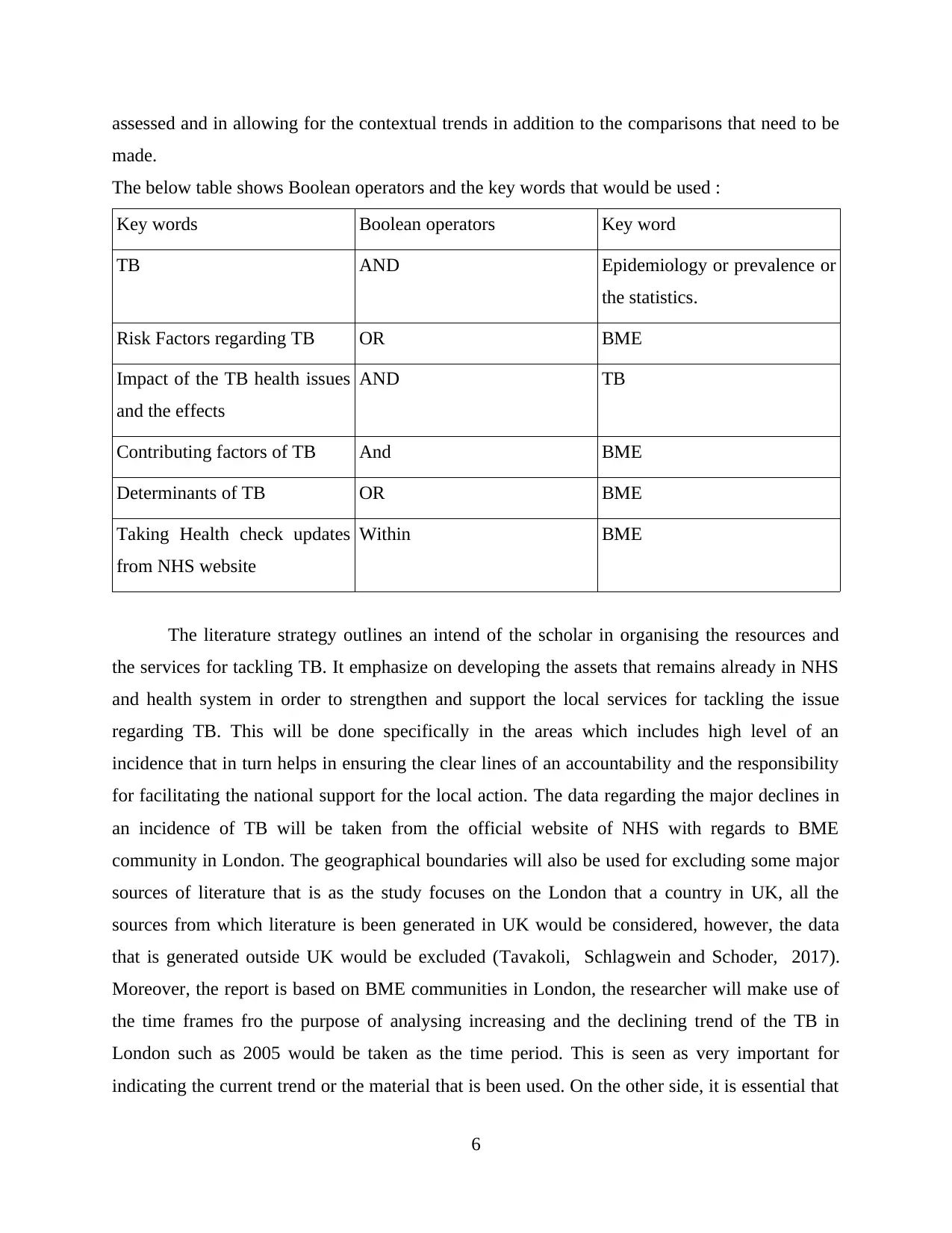
assessed and in allowing for the contextual trends in addition to the comparisons that need to be
made.
The below table shows Boolean operators and the key words that would be used :
Key words Boolean operators Key word
TB AND Epidemiology or prevalence or
the statistics.
Risk Factors regarding TB OR BME
Impact of the TB health issues
and the effects
AND TB
Contributing factors of TB And BME
Determinants of TB OR BME
Taking Health check updates
from NHS website
Within BME
The literature strategy outlines an intend of the scholar in organising the resources and
the services for tackling TB. It emphasize on developing the assets that remains already in NHS
and health system in order to strengthen and support the local services for tackling the issue
regarding TB. This will be done specifically in the areas which includes high level of an
incidence that in turn helps in ensuring the clear lines of an accountability and the responsibility
for facilitating the national support for the local action. The data regarding the major declines in
an incidence of TB will be taken from the official website of NHS with regards to BME
community in London. The geographical boundaries will also be used for excluding some major
sources of literature that is as the study focuses on the London that a country in UK, all the
sources from which literature is been generated in UK would be considered, however, the data
that is generated outside UK would be excluded (Tavakoli, Schlagwein and Schoder, 2017).
Moreover, the report is based on BME communities in London, the researcher will make use of
the time frames fro the purpose of analysing increasing and the declining trend of the TB in
London such as 2005 would be taken as the time period. This is seen as very important for
indicating the current trend or the material that is been used. On the other side, it is essential that
6
made.
The below table shows Boolean operators and the key words that would be used :
Key words Boolean operators Key word
TB AND Epidemiology or prevalence or
the statistics.
Risk Factors regarding TB OR BME
Impact of the TB health issues
and the effects
AND TB
Contributing factors of TB And BME
Determinants of TB OR BME
Taking Health check updates
from NHS website
Within BME
The literature strategy outlines an intend of the scholar in organising the resources and
the services for tackling TB. It emphasize on developing the assets that remains already in NHS
and health system in order to strengthen and support the local services for tackling the issue
regarding TB. This will be done specifically in the areas which includes high level of an
incidence that in turn helps in ensuring the clear lines of an accountability and the responsibility
for facilitating the national support for the local action. The data regarding the major declines in
an incidence of TB will be taken from the official website of NHS with regards to BME
community in London. The geographical boundaries will also be used for excluding some major
sources of literature that is as the study focuses on the London that a country in UK, all the
sources from which literature is been generated in UK would be considered, however, the data
that is generated outside UK would be excluded (Tavakoli, Schlagwein and Schoder, 2017).
Moreover, the report is based on BME communities in London, the researcher will make use of
the time frames fro the purpose of analysing increasing and the declining trend of the TB in
London such as 2005 would be taken as the time period. This is seen as very important for
indicating the current trend or the material that is been used. On the other side, it is essential that
6
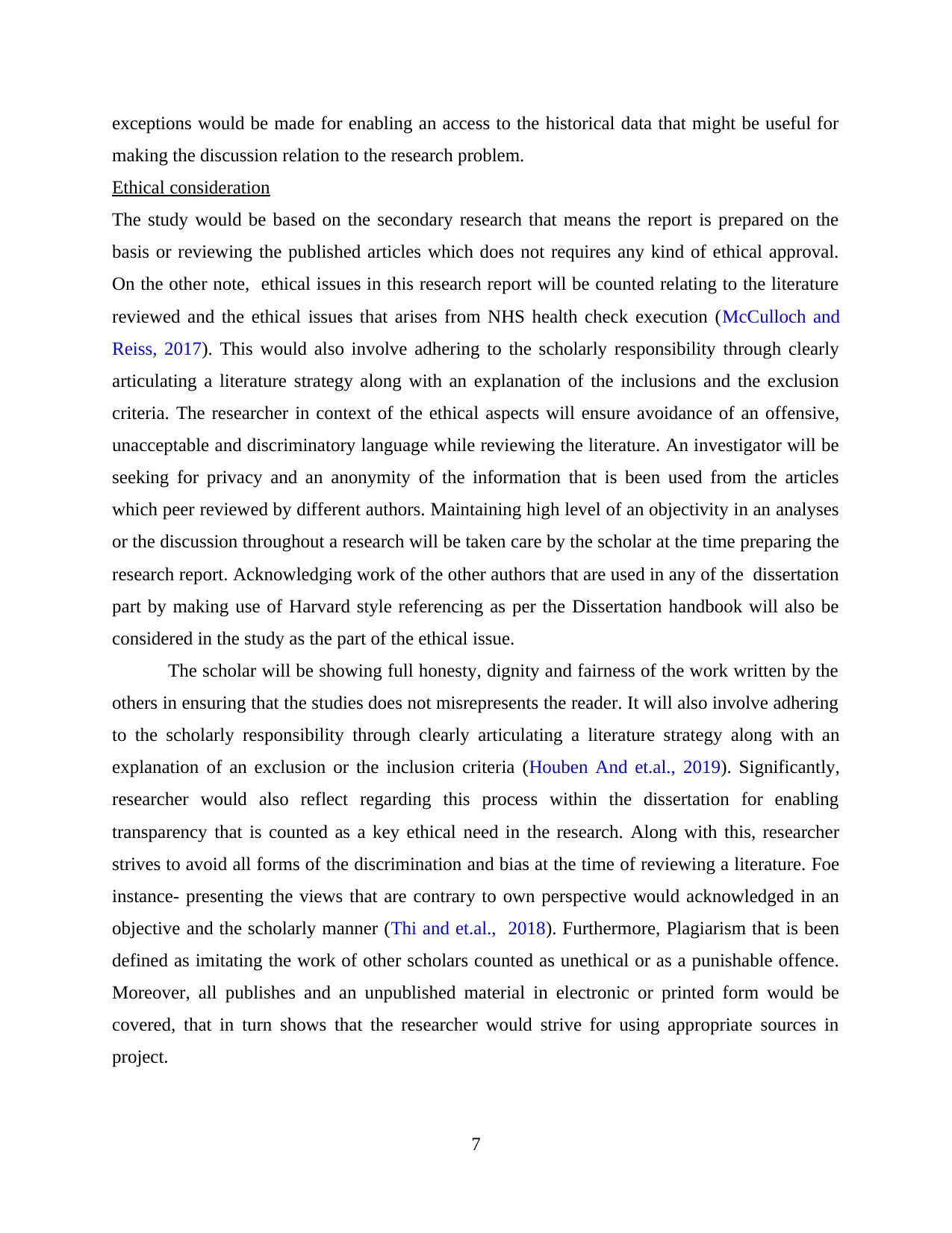
exceptions would be made for enabling an access to the historical data that might be useful for
making the discussion relation to the research problem.
Ethical consideration
The study would be based on the secondary research that means the report is prepared on the
basis or reviewing the published articles which does not requires any kind of ethical approval.
On the other note, ethical issues in this research report will be counted relating to the literature
reviewed and the ethical issues that arises from NHS health check execution (McCulloch and
Reiss, 2017). This would also involve adhering to the scholarly responsibility through clearly
articulating a literature strategy along with an explanation of the inclusions and the exclusion
criteria. The researcher in context of the ethical aspects will ensure avoidance of an offensive,
unacceptable and discriminatory language while reviewing the literature. An investigator will be
seeking for privacy and an anonymity of the information that is been used from the articles
which peer reviewed by different authors. Maintaining high level of an objectivity in an analyses
or the discussion throughout a research will be taken care by the scholar at the time preparing the
research report. Acknowledging work of the other authors that are used in any of the dissertation
part by making use of Harvard style referencing as per the Dissertation handbook will also be
considered in the study as the part of the ethical issue.
The scholar will be showing full honesty, dignity and fairness of the work written by the
others in ensuring that the studies does not misrepresents the reader. It will also involve adhering
to the scholarly responsibility through clearly articulating a literature strategy along with an
explanation of an exclusion or the inclusion criteria (Houben And et.al., 2019). Significantly,
researcher would also reflect regarding this process within the dissertation for enabling
transparency that is counted as a key ethical need in the research. Along with this, researcher
strives to avoid all forms of the discrimination and bias at the time of reviewing a literature. Foe
instance- presenting the views that are contrary to own perspective would acknowledged in an
objective and the scholarly manner (Thi and et.al., 2018). Furthermore, Plagiarism that is been
defined as imitating the work of other scholars counted as unethical or as a punishable offence.
Moreover, all publishes and an unpublished material in electronic or printed form would be
covered, that in turn shows that the researcher would strive for using appropriate sources in
project.
7
making the discussion relation to the research problem.
Ethical consideration
The study would be based on the secondary research that means the report is prepared on the
basis or reviewing the published articles which does not requires any kind of ethical approval.
On the other note, ethical issues in this research report will be counted relating to the literature
reviewed and the ethical issues that arises from NHS health check execution (McCulloch and
Reiss, 2017). This would also involve adhering to the scholarly responsibility through clearly
articulating a literature strategy along with an explanation of the inclusions and the exclusion
criteria. The researcher in context of the ethical aspects will ensure avoidance of an offensive,
unacceptable and discriminatory language while reviewing the literature. An investigator will be
seeking for privacy and an anonymity of the information that is been used from the articles
which peer reviewed by different authors. Maintaining high level of an objectivity in an analyses
or the discussion throughout a research will be taken care by the scholar at the time preparing the
research report. Acknowledging work of the other authors that are used in any of the dissertation
part by making use of Harvard style referencing as per the Dissertation handbook will also be
considered in the study as the part of the ethical issue.
The scholar will be showing full honesty, dignity and fairness of the work written by the
others in ensuring that the studies does not misrepresents the reader. It will also involve adhering
to the scholarly responsibility through clearly articulating a literature strategy along with an
explanation of an exclusion or the inclusion criteria (Houben And et.al., 2019). Significantly,
researcher would also reflect regarding this process within the dissertation for enabling
transparency that is counted as a key ethical need in the research. Along with this, researcher
strives to avoid all forms of the discrimination and bias at the time of reviewing a literature. Foe
instance- presenting the views that are contrary to own perspective would acknowledged in an
objective and the scholarly manner (Thi and et.al., 2018). Furthermore, Plagiarism that is been
defined as imitating the work of other scholars counted as unethical or as a punishable offence.
Moreover, all publishes and an unpublished material in electronic or printed form would be
covered, that in turn shows that the researcher would strive for using appropriate sources in
project.
7
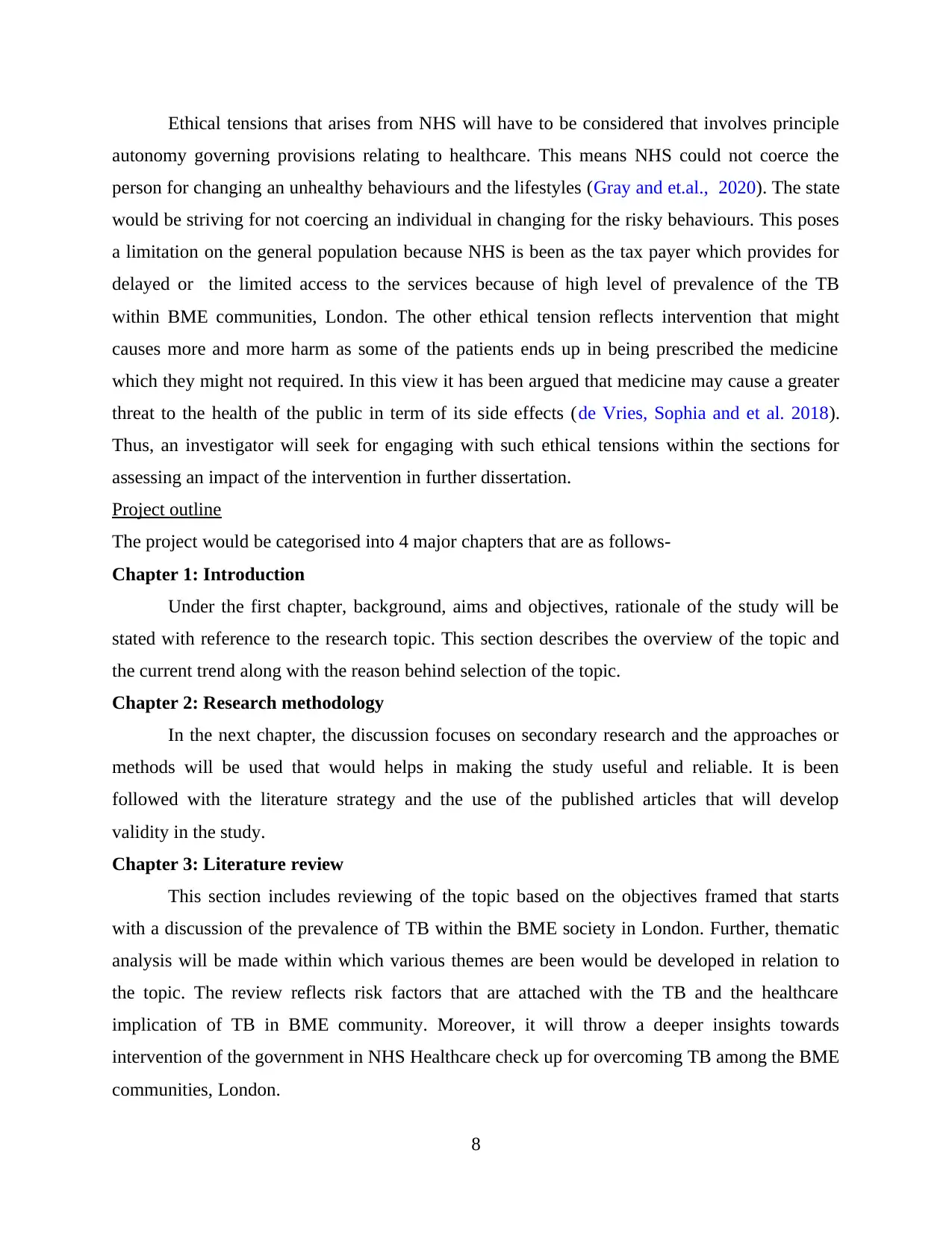
Ethical tensions that arises from NHS will have to be considered that involves principle
autonomy governing provisions relating to healthcare. This means NHS could not coerce the
person for changing an unhealthy behaviours and the lifestyles (Gray and et.al., 2020). The state
would be striving for not coercing an individual in changing for the risky behaviours. This poses
a limitation on the general population because NHS is been as the tax payer which provides for
delayed or the limited access to the services because of high level of prevalence of the TB
within BME communities, London. The other ethical tension reflects intervention that might
causes more and more harm as some of the patients ends up in being prescribed the medicine
which they might not required. In this view it has been argued that medicine may cause a greater
threat to the health of the public in term of its side effects (de Vries, Sophia and et al. 2018).
Thus, an investigator will seek for engaging with such ethical tensions within the sections for
assessing an impact of the intervention in further dissertation.
Project outline
The project would be categorised into 4 major chapters that are as follows-
Chapter 1: Introduction
Under the first chapter, background, aims and objectives, rationale of the study will be
stated with reference to the research topic. This section describes the overview of the topic and
the current trend along with the reason behind selection of the topic.
Chapter 2: Research methodology
In the next chapter, the discussion focuses on secondary research and the approaches or
methods will be used that would helps in making the study useful and reliable. It is been
followed with the literature strategy and the use of the published articles that will develop
validity in the study.
Chapter 3: Literature review
This section includes reviewing of the topic based on the objectives framed that starts
with a discussion of the prevalence of TB within the BME society in London. Further, thematic
analysis will be made within which various themes are been would be developed in relation to
the topic. The review reflects risk factors that are attached with the TB and the healthcare
implication of TB in BME community. Moreover, it will throw a deeper insights towards
intervention of the government in NHS Healthcare check up for overcoming TB among the BME
communities, London.
8
autonomy governing provisions relating to healthcare. This means NHS could not coerce the
person for changing an unhealthy behaviours and the lifestyles (Gray and et.al., 2020). The state
would be striving for not coercing an individual in changing for the risky behaviours. This poses
a limitation on the general population because NHS is been as the tax payer which provides for
delayed or the limited access to the services because of high level of prevalence of the TB
within BME communities, London. The other ethical tension reflects intervention that might
causes more and more harm as some of the patients ends up in being prescribed the medicine
which they might not required. In this view it has been argued that medicine may cause a greater
threat to the health of the public in term of its side effects (de Vries, Sophia and et al. 2018).
Thus, an investigator will seek for engaging with such ethical tensions within the sections for
assessing an impact of the intervention in further dissertation.
Project outline
The project would be categorised into 4 major chapters that are as follows-
Chapter 1: Introduction
Under the first chapter, background, aims and objectives, rationale of the study will be
stated with reference to the research topic. This section describes the overview of the topic and
the current trend along with the reason behind selection of the topic.
Chapter 2: Research methodology
In the next chapter, the discussion focuses on secondary research and the approaches or
methods will be used that would helps in making the study useful and reliable. It is been
followed with the literature strategy and the use of the published articles that will develop
validity in the study.
Chapter 3: Literature review
This section includes reviewing of the topic based on the objectives framed that starts
with a discussion of the prevalence of TB within the BME society in London. Further, thematic
analysis will be made within which various themes are been would be developed in relation to
the topic. The review reflects risk factors that are attached with the TB and the healthcare
implication of TB in BME community. Moreover, it will throw a deeper insights towards
intervention of the government in NHS Healthcare check up for overcoming TB among the BME
communities, London.
8
Secure Best Marks with AI Grader
Need help grading? Try our AI Grader for instant feedback on your assignments.
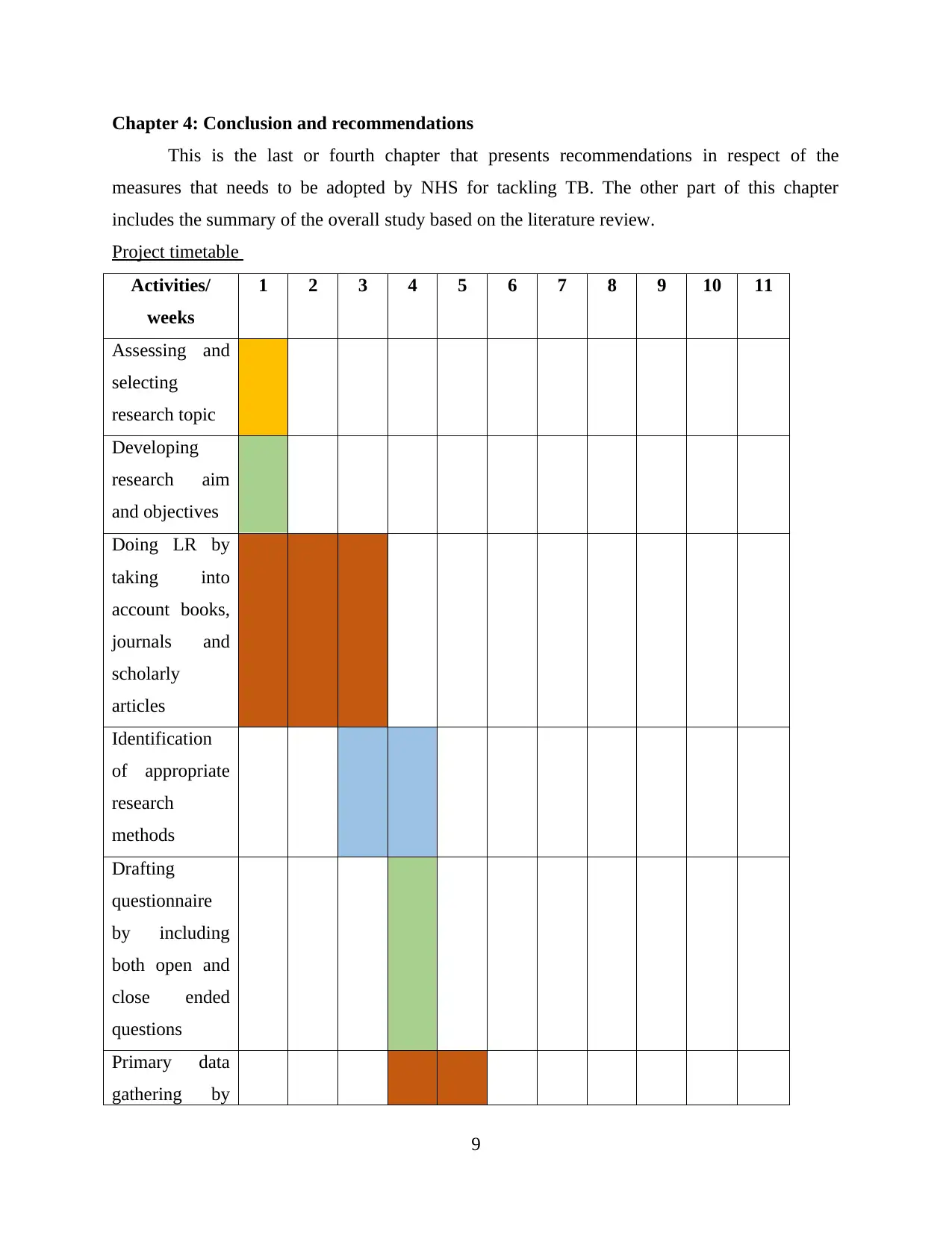
Chapter 4: Conclusion and recommendations
This is the last or fourth chapter that presents recommendations in respect of the
measures that needs to be adopted by NHS for tackling TB. The other part of this chapter
includes the summary of the overall study based on the literature review.
Project timetable
Activities/
weeks
1 2 3 4 5 6 7 8 9 10 11
Assessing and
selecting
research topic
Developing
research aim
and objectives
Doing LR by
taking into
account books,
journals and
scholarly
articles
Identification
of appropriate
research
methods
Drafting
questionnaire
by including
both open and
close ended
questions
Primary data
gathering by
9
This is the last or fourth chapter that presents recommendations in respect of the
measures that needs to be adopted by NHS for tackling TB. The other part of this chapter
includes the summary of the overall study based on the literature review.
Project timetable
Activities/
weeks
1 2 3 4 5 6 7 8 9 10 11
Assessing and
selecting
research topic
Developing
research aim
and objectives
Doing LR by
taking into
account books,
journals and
scholarly
articles
Identification
of appropriate
research
methods
Drafting
questionnaire
by including
both open and
close ended
questions
Primary data
gathering by
9
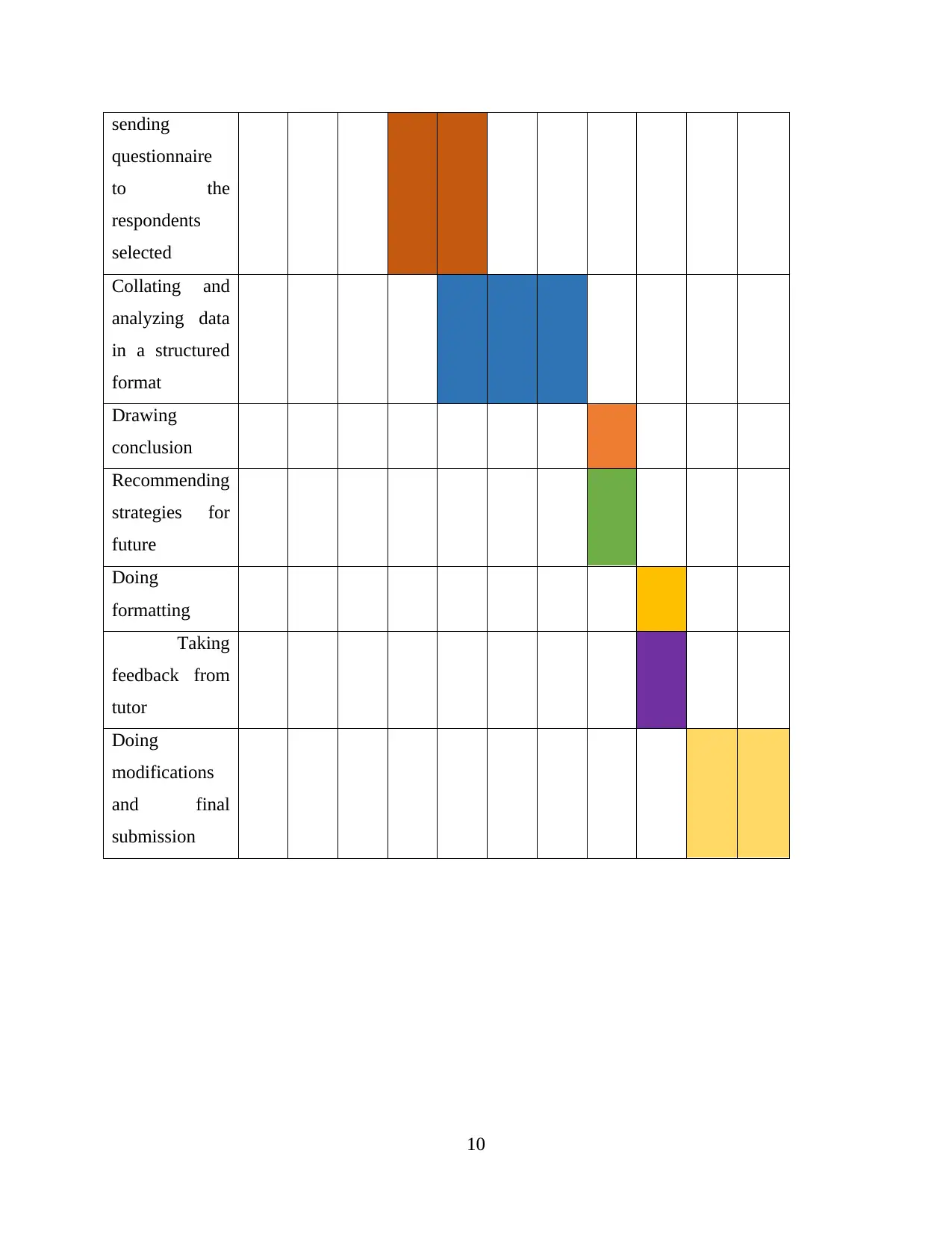
sending
questionnaire
to the
respondents
selected
Collating and
analyzing data
in a structured
format
Drawing
conclusion
Recommending
strategies for
future
Doing
formatting
Taking
feedback from
tutor
Doing
modifications
and final
submission
10
questionnaire
to the
respondents
selected
Collating and
analyzing data
in a structured
format
Drawing
conclusion
Recommending
strategies for
future
Doing
formatting
Taking
feedback from
tutor
Doing
modifications
and final
submission
10
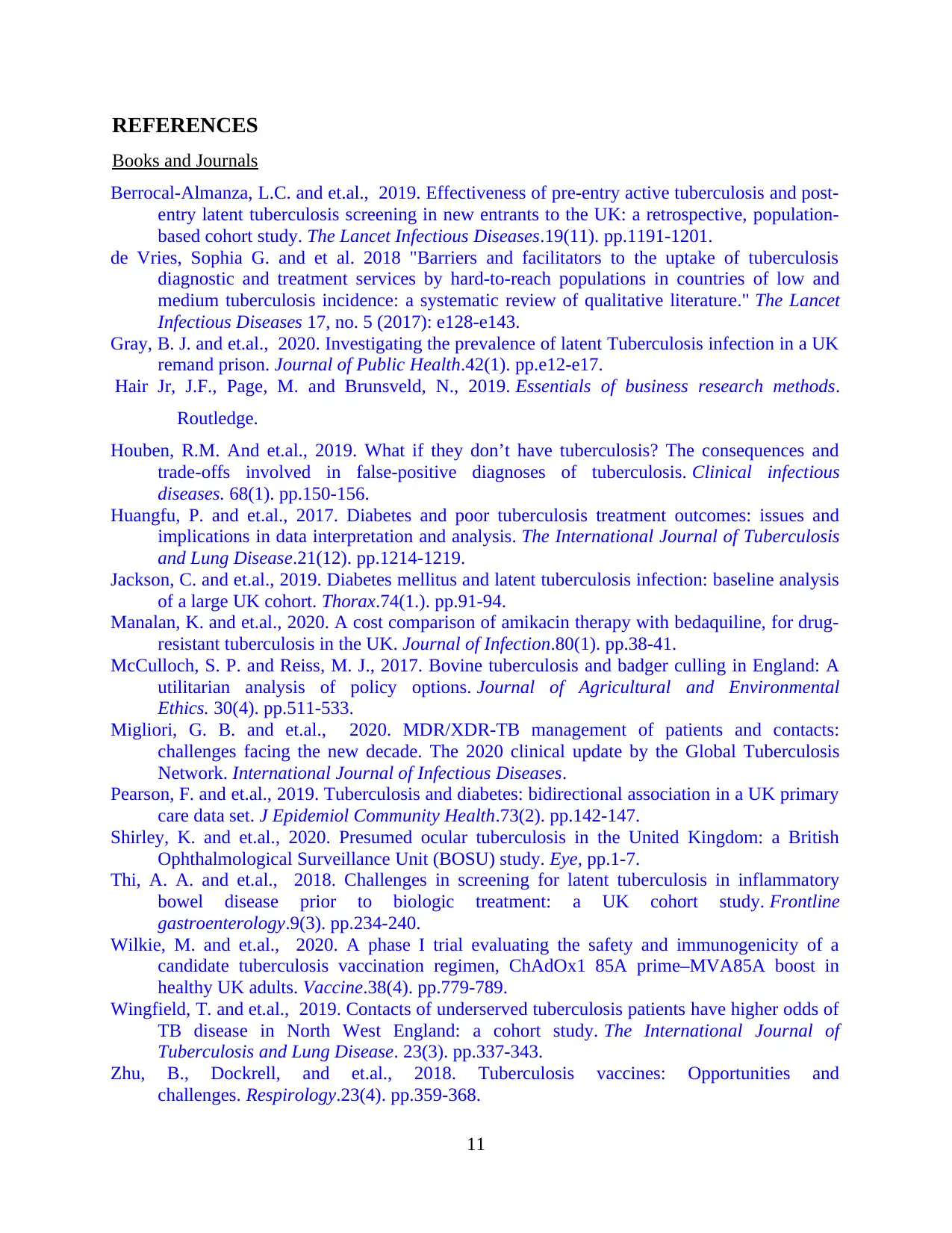
REFERENCES
Books and Journals
Berrocal-Almanza, L.C. and et.al., 2019. Effectiveness of pre-entry active tuberculosis and post-
entry latent tuberculosis screening in new entrants to the UK: a retrospective, population-
based cohort study. The Lancet Infectious Diseases.19(11). pp.1191-1201.
de Vries, Sophia G. and et al. 2018 "Barriers and facilitators to the uptake of tuberculosis
diagnostic and treatment services by hard-to-reach populations in countries of low and
medium tuberculosis incidence: a systematic review of qualitative literature." The Lancet
Infectious Diseases 17, no. 5 (2017): e128-e143.
Gray, B. J. and et.al., 2020. Investigating the prevalence of latent Tuberculosis infection in a UK
remand prison. Journal of Public Health.42(1). pp.e12-e17.
Hair Jr, J.F., Page, M. and Brunsveld, N., 2019. Essentials of business research methods.
Routledge.
Houben, R.M. And et.al., 2019. What if they don’t have tuberculosis? The consequences and
trade-offs involved in false-positive diagnoses of tuberculosis. Clinical infectious
diseases. 68(1). pp.150-156.
Huangfu, P. and et.al., 2017. Diabetes and poor tuberculosis treatment outcomes: issues and
implications in data interpretation and analysis. The International Journal of Tuberculosis
and Lung Disease.21(12). pp.1214-1219.
Jackson, C. and et.al., 2019. Diabetes mellitus and latent tuberculosis infection: baseline analysis
of a large UK cohort. Thorax.74(1.). pp.91-94.
Manalan, K. and et.al., 2020. A cost comparison of amikacin therapy with bedaquiline, for drug-
resistant tuberculosis in the UK. Journal of Infection.80(1). pp.38-41.
McCulloch, S. P. and Reiss, M. J., 2017. Bovine tuberculosis and badger culling in England: A
utilitarian analysis of policy options. Journal of Agricultural and Environmental
Ethics. 30(4). pp.511-533.
Migliori, G. B. and et.al., 2020. MDR/XDR-TB management of patients and contacts:
challenges facing the new decade. The 2020 clinical update by the Global Tuberculosis
Network. International Journal of Infectious Diseases.
Pearson, F. and et.al., 2019. Tuberculosis and diabetes: bidirectional association in a UK primary
care data set. J Epidemiol Community Health.73(2). pp.142-147.
Shirley, K. and et.al., 2020. Presumed ocular tuberculosis in the United Kingdom: a British
Ophthalmological Surveillance Unit (BOSU) study. Eye, pp.1-7.
Thi, A. A. and et.al., 2018. Challenges in screening for latent tuberculosis in inflammatory
bowel disease prior to biologic treatment: a UK cohort study. Frontline
gastroenterology.9(3). pp.234-240.
Wilkie, M. and et.al., 2020. A phase I trial evaluating the safety and immunogenicity of a
candidate tuberculosis vaccination regimen, ChAdOx1 85A prime–MVA85A boost in
healthy UK adults. Vaccine.38(4). pp.779-789.
Wingfield, T. and et.al., 2019. Contacts of underserved tuberculosis patients have higher odds of
TB disease in North West England: a cohort study. The International Journal of
Tuberculosis and Lung Disease. 23(3). pp.337-343.
Zhu, B., Dockrell, and et.al., 2018. Tuberculosis vaccines: Opportunities and
challenges. Respirology.23(4). pp.359-368.
11
Books and Journals
Berrocal-Almanza, L.C. and et.al., 2019. Effectiveness of pre-entry active tuberculosis and post-
entry latent tuberculosis screening in new entrants to the UK: a retrospective, population-
based cohort study. The Lancet Infectious Diseases.19(11). pp.1191-1201.
de Vries, Sophia G. and et al. 2018 "Barriers and facilitators to the uptake of tuberculosis
diagnostic and treatment services by hard-to-reach populations in countries of low and
medium tuberculosis incidence: a systematic review of qualitative literature." The Lancet
Infectious Diseases 17, no. 5 (2017): e128-e143.
Gray, B. J. and et.al., 2020. Investigating the prevalence of latent Tuberculosis infection in a UK
remand prison. Journal of Public Health.42(1). pp.e12-e17.
Hair Jr, J.F., Page, M. and Brunsveld, N., 2019. Essentials of business research methods.
Routledge.
Houben, R.M. And et.al., 2019. What if they don’t have tuberculosis? The consequences and
trade-offs involved in false-positive diagnoses of tuberculosis. Clinical infectious
diseases. 68(1). pp.150-156.
Huangfu, P. and et.al., 2017. Diabetes and poor tuberculosis treatment outcomes: issues and
implications in data interpretation and analysis. The International Journal of Tuberculosis
and Lung Disease.21(12). pp.1214-1219.
Jackson, C. and et.al., 2019. Diabetes mellitus and latent tuberculosis infection: baseline analysis
of a large UK cohort. Thorax.74(1.). pp.91-94.
Manalan, K. and et.al., 2020. A cost comparison of amikacin therapy with bedaquiline, for drug-
resistant tuberculosis in the UK. Journal of Infection.80(1). pp.38-41.
McCulloch, S. P. and Reiss, M. J., 2017. Bovine tuberculosis and badger culling in England: A
utilitarian analysis of policy options. Journal of Agricultural and Environmental
Ethics. 30(4). pp.511-533.
Migliori, G. B. and et.al., 2020. MDR/XDR-TB management of patients and contacts:
challenges facing the new decade. The 2020 clinical update by the Global Tuberculosis
Network. International Journal of Infectious Diseases.
Pearson, F. and et.al., 2019. Tuberculosis and diabetes: bidirectional association in a UK primary
care data set. J Epidemiol Community Health.73(2). pp.142-147.
Shirley, K. and et.al., 2020. Presumed ocular tuberculosis in the United Kingdom: a British
Ophthalmological Surveillance Unit (BOSU) study. Eye, pp.1-7.
Thi, A. A. and et.al., 2018. Challenges in screening for latent tuberculosis in inflammatory
bowel disease prior to biologic treatment: a UK cohort study. Frontline
gastroenterology.9(3). pp.234-240.
Wilkie, M. and et.al., 2020. A phase I trial evaluating the safety and immunogenicity of a
candidate tuberculosis vaccination regimen, ChAdOx1 85A prime–MVA85A boost in
healthy UK adults. Vaccine.38(4). pp.779-789.
Wingfield, T. and et.al., 2019. Contacts of underserved tuberculosis patients have higher odds of
TB disease in North West England: a cohort study. The International Journal of
Tuberculosis and Lung Disease. 23(3). pp.337-343.
Zhu, B., Dockrell, and et.al., 2018. Tuberculosis vaccines: Opportunities and
challenges. Respirology.23(4). pp.359-368.
11
Paraphrase This Document
Need a fresh take? Get an instant paraphrase of this document with our AI Paraphraser

Online
TB rises in UK and London. 2018. [Online]. Available through:
<https://www.nhs.uk/news/medical-practice/tb-rises-in-uk-and-london/>.
12
TB rises in UK and London. 2018. [Online]. Available through:
<https://www.nhs.uk/news/medical-practice/tb-rises-in-uk-and-london/>.
12
1 out of 14
Related Documents
Your All-in-One AI-Powered Toolkit for Academic Success.
+13062052269
info@desklib.com
Available 24*7 on WhatsApp / Email
![[object Object]](/_next/static/media/star-bottom.7253800d.svg)
Unlock your academic potential
© 2024 | Zucol Services PVT LTD | All rights reserved.





![Tuberculosis: A Global Health Problem Report - [University Name]](/_next/image/?url=https%3A%2F%2Fdesklib.com%2Fmedia%2Fimages%2Frm%2F9203536188144271bb8888f35ea5092d.jpg&w=256&q=75)